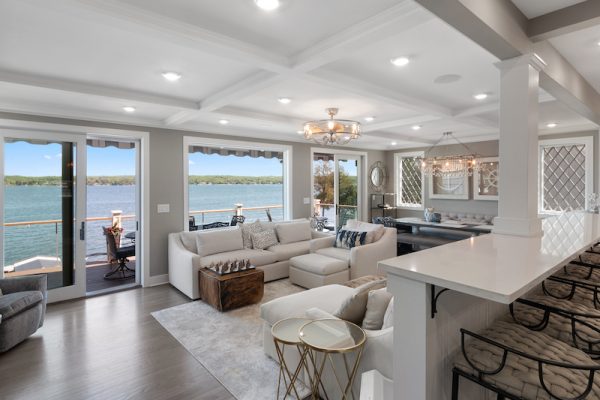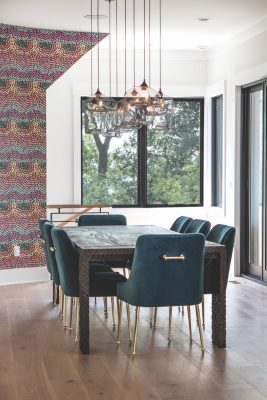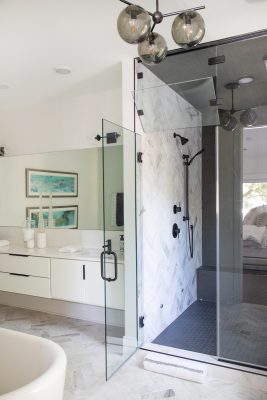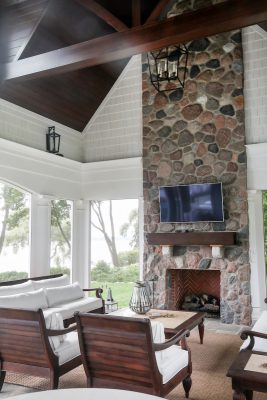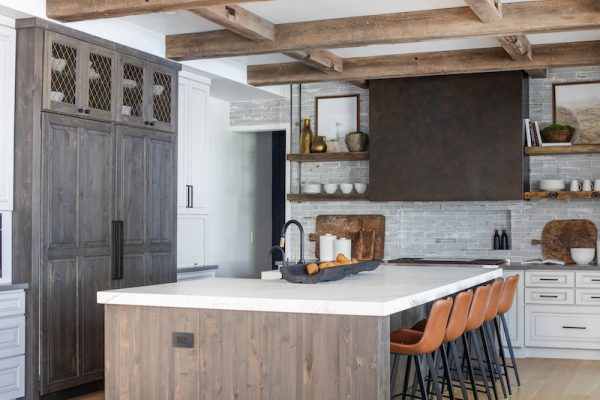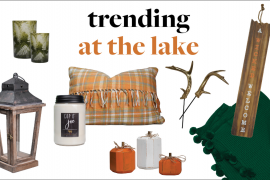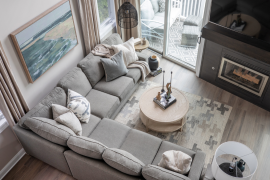By Rachel Wisinski | Opening photo by Ensure Productions
In the 30 years he’s spent building custom homes, John Matustik of Matustik Builders says the industry has evolved in many ways. Gone are the days of designing multiple-use homes with huge great rooms, family rooms and bedrooms, Matustik says. Instead, homeowners are opting to shift the focal point of each room to the furniture. “For us, it’s an art to design a home that’s cozy enough for a couple [to live in], but when they have 50 people over for a party or for the weekend, it doesn’t feel cramped or closed in,” Matustik says.
Most people look for a way to optimize the space they have, within their budget. A home with an open floor plan, a design that has been popular for nearly two decades now, continues to dominate the top trends. This sometimes includes opening up lower ceilings to make a room feel more spacious, as well as increasing the number of windows in a room.
Matustik says multipurpose spaces within a home have grown in popularity over the years as well. Mudrooms have increased in size and functionality. Bathrooms are being fully revamped, complete with luxury, walk-in showers with multiple rain heads, body sprays and other features.
Jeff Auberger, a design and remodeling consultant at Stebnitz Builders who has been with the company for more than six years, says new hardware styles have begun to “push the envelope” and vary from the traditional options that dominated the market in the past. Auberger attributes this at least partly to the fact that Baby Boomers are considering how they’ll get around the house as they grow older. These aging-in-place design elements often dictate the choices homeowners make, Auberger says, and the hardware available today supports such design considerations. Among the features gaining ground are grab bars and unique toilet paper dispensers.
Dedicated entertainment spaces within the home have gained popularity: these may include golf simulators, secondary kitchens or bars and screened-in rooms with retractable windows. “These days, homes are more than just a place to sleep,” Matustik explains. “It’s a place for entertaining, for family, for bonding.”
Auberger says that when it comes to design trends, homeowners tend to want to mix traditional elements — often farmhouse elements — with something more modern, including elements of the still-wildly-popular mid-century designs or nods to the burgeoning resurgence of 1980’s contemporary elements. Natural tones and complementary colors remain popular, along with the implementation of softer wood tones or distressed materials, according to Auberger.
While homeowners in other areas of the country may be showing fatigue with the “modern farmhouse” look that has dominated design for the past decade, Auberger says the trend is still going strong in the Geneva Lake area. “There’s a striking contrast [in the modern farmhouse look] that continues to be strongly appealing to people in our market,” he explains.
Sustainable building and the idea of “going green” has gained ground here recently and continues to be an element of interest, Auberger says. This can include the practice of using reclaimed wood in home interiors — often as a wall treatment, fireplace mantel or open shelving — which has the added bonus of creating a distinctive look that works well with both traditional and modern designs. Updating the home’s systems for environmental sustainability has the added advantage of making the space more luxurious as well. “When we go in, we make sure we’re modernizing everything — introducing everything from smart home technology, lighting and controls to incorporating music and sound that can be heard throughout the home,” Auberger says.
Both Auberger and Matustik say they have seen a shift in some home trends in recent years: theater rooms are a thing of the past; instead homeowners are opting to enjoy their views with the addition of three- season rooms. For outdoor spaces, fire pits take precedence.
Of course, when designing a new home or a remodel, the most important thing to consider is not the latest trends, but how each family lives, how they use the home and what designs they prefer, Matustik explains. “It’s the client we really focus on,” he says.

